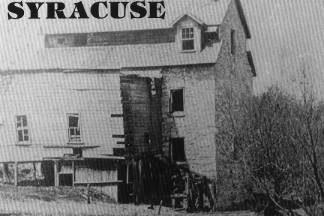
Syracuse had an unusual origin. The name appears at a site southeast of Unadilla in 1856, nearly six miles west of its present location where salt was discovered. To claim the land, the "Syracuse Town Company" was formed. Named for the great salt entity in New York, it was hoped that a similar market would develop. Salt mining was not successful and it soon died down, but the name was not forgotten. A "postal drop" established at a farm in Syracuse precinct was lost in 1863 when another man acquired the office and moved it to his place of business on "Nursery Hill," west of our present location. Some historians suggest that present-day Syracuse was an outgrowth of that settlement. However, those observations are not entirely correct, since the earlier Syracuse postal address was moved to Nursery Hill, it was not the predecessor -- only an interim step. The first root for the present town of Syracuse was planted in the late 1850s when a school was established. It continued as settlement increased. In 1869, when talk of a railroad coming through the area got serious, a Mr. Thorn gave 100 acres of land to the Midland Pacific Railway, and Dr. J. N. Converse and L.E. Sinsabaugh laid out a town. In 1871, when the railroad was completed to Lincoln, the station was given the name "Syracuse." The importance of the railroad was immediately felt. As Syracuse became a major shipping point in the county, buildings sprang up at a rapid pace. Nursery Hill's two stores and post office were moved to the new town, and on March 6, 1872, the post office became "Syracuse" again. Incorporation was accomplished on January 6, 1875. Syracuse also grew as an agricultural center. In 1878 over 350 cars of grain and 100 carloads of livestock were shipped from this station. The original town was built primarily on the bottomland near the tracks, but it gradually moved to the higher ground. By 1879 the population was upwards of 500 residents, and in 1882 over 80 services were listed, including a carriage factory. A stone quarry was developed five miles from Syracuse. Some of its light-gray stone was used to build the state penitentiary at Lincoln. Gradual but steady growth is noted, with the population at 510 in 1880, 728 in 1890, and 861 by 1900. With community infrastructure in place, the 1992 population of 1,671 represents a solid citizenry, and the highest to date. Syracuse's schools played a major role in its continued existence, with 31 students registered in 1859. (The average attendance, however, was only five.) During railroad construction in 1870, a new schoolhouse was built for the 50 pupils. Other buildings were needed in 1880 and again in 1890. Enrollment was 330 by 1900. An annex was built to the main building in 1925. These buildings were replaced in 1943, and a new high school was built in 1963. Now a consolidated district known as Syracuse-Dunbar-Avoca, serves over 600 students from this area. The first church was built in 1873, with others in 1887 and 1880. A number of fraternal and social organizations also appeared in the community. Because of its central location, the county fair was moved to Syracuse in 1883. A half-mile race track was constructed and became well-known throughout the state, with huge crowds gathering, especially on the Fourth of July. While athletic events, such as ball games, became very important in the late 1890s, probably the greatest center for social activity was the opera house. Moving pictures first appeared in 1901. In May 1899 Henry Coit of St. Louis established a telephone exchange. Rent was $1 per month for a residence, and $2 for businesses. The next civic improvement was a water system and standpipe. By 1915 electricity was sought for the town. Concrete started replacing boardwalks in 1902, with six blocks of main street paved in 1923 and another 24 blocks surfaced the following year. The activity which came in the early 1900s provided a strong basis for the town, and made it appear much more advanced than other communities its size. As the railroad era diminished, Syracuse did not die. Instead it recognized its reason for existence -- the rich soil on which it had been founded and the agricultural potential of it. Syracuse stands as an example of the struggles and successes endured to became an established town on the Nebraska prairie.
By the Otoe County Museum Society, Norma Jean Dettmer, president, 366 Poplar, Syracuse, NE 68446. ADDITIONAL MATERIAL: For The Record , 1972, a centennial history of Syracuse by Margaret Dale Masters; and Otoe County History , 1983, Otoe County Historical Society and Otoe County Museum Society. |
| Home | Contact |
© NEGenWeb
